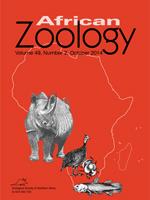We compared crevice fidelity among solitary and group-living individuals in a population of the group-living lizard Ouroborus cataphractus. We also compared the incidence of solitary individuals between the sexes and different seasons. We surveyed suitable rocky areas at two sites in the Graafwater district, South Africa, and all O. cataphractus individuals found, whether in groups or solitary, were marked and released back into their crevices. The areas were resurveyed after one month, three months and four months to compare crevice fidelity of solitary and group-living individuals. We found that solitary individuals were significantly less loyal to their rock shelters than individuals living in groups, and that solitary females appeared to be less loyal than solitary males. We found no significant difference in the frequency of solitary adult males in and outside of the mating season. Solitary adult males were significantly smaller in mean body size than group-living adult males, but did not have more scars or other deformities than the latter. We found no significant difference in the frequencies of solitary individuals during the wet and the dry seasons, or in the frequencies of solitary adult males versus solitary adult females recorded during any of the surveys. The significantly lower crevice fidelity displayed by solitary than group-living individuals supports the notion that being in a group must be the optimal situation for individuals of this relatively slow-moving cordylid. Our finding that solitary adult males were significantly smaller in mean body size than group-living adult males also suggests that the exclusion of less competitive males from groups may in part be responsible for the occurrence of solitary males.
BioOne.org will be down briefly for maintenance on 12 February 2025 between 18:00-21:00 Pacific Time US. We apologize for any inconvenience.
How to translate text using browser tools
1 October 2014
Solitary Individuals in Populations of the Group-Living Lizard Ouroborus Cataphractus: Voluntary or Forced?
P. le Fras N. Mouton,
Janine L. Glover,
Alexander F. Flemming
ACCESS THE FULL ARTICLE

African Zoology
Vol. 49 • No. 2
October 2014
Vol. 49 • No. 2
October 2014
competitive exclusion
Cordylidae
crevicefidelity
mark-recapture
seasonal differences
sexual differences




